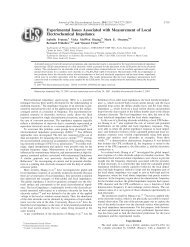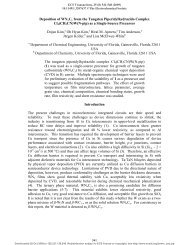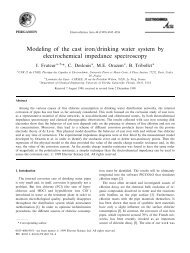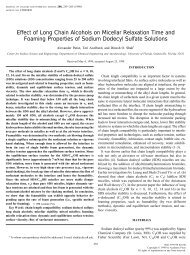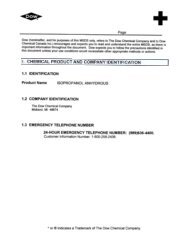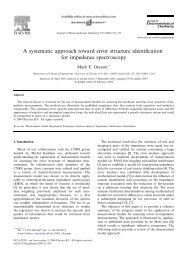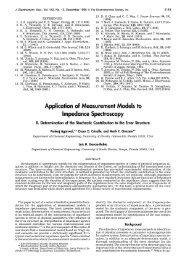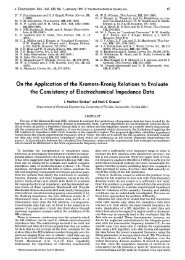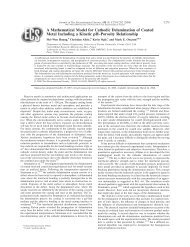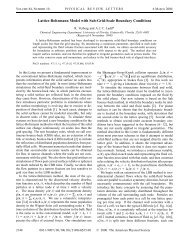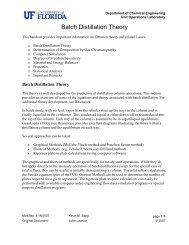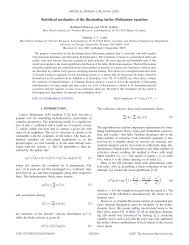7136 J. Phys. Chem. B, Vol. 105, No. 29, 2001 Dhara and Shah Figure 5. Effect <strong>of</strong> anionic polymers as a function <strong>of</strong> molarity <strong>of</strong> repeat<strong>in</strong>g unit <strong>of</strong> polymers on <strong>the</strong> slow relaxation time (τ 2) <strong>of</strong> 200 mM SDS: (4) CMC Na, (0) PAA Na, and (]) PAA. Figure 7. Relation between surface activity <strong>of</strong> cellulose derivatives and <strong>the</strong>ir effect on <strong>the</strong> slow relaxation time (τ 2) <strong>of</strong> 200 mM SDS: (0) τ 2 and (O) surface tension. Figure 8. Relation between surface activity <strong>of</strong> <strong>the</strong> syn<strong>the</strong>tic polymers and <strong>the</strong>ir effect on <strong>the</strong> slow relaxation time (τ 2) <strong>of</strong> 200 mM SDS: (b) τ 2 and (O) surface tension. Figure 6. Effect <strong>of</strong> cationic polymers at different concentration on <strong>the</strong> slow relaxation time (τ 2) <strong>of</strong> 200 mM SDS: (]) LM-200, (0) JR 400, and (4) PEI. that SDS does not <strong>in</strong>teract with PAA Na and CMC Na by Zana et, al. 42 and Schwuger et al., 43 respectively. These results aga<strong>in</strong> <strong>in</strong>dicate that <strong>the</strong> polymers that <strong>in</strong>teract strongly with SDS decrease its micellar stability. Figure 6 shows <strong>the</strong> effect <strong>of</strong> cationic polymers on <strong>the</strong> stability <strong>of</strong> 200 mM SDS. All <strong>the</strong> three polymers reduced <strong>the</strong> stability, <strong>the</strong> effect be<strong>in</strong>g a maximum for PEI. The strong <strong>in</strong>teraction between PEI and SDS is well-studied by W<strong>in</strong>nik and co-workers 44 and Wyn-Jones et al.; 45 <strong>in</strong>teractions between JR 400 and LM-200 with SDS are also reported. 46,47 The strong <strong>in</strong>teraction between oppositely charged polymers and SDS is not surpris<strong>in</strong>g, s<strong>in</strong>ce very strong electrostatic forces <strong>of</strong> attraction are <strong>in</strong>volved. The k<strong>in</strong>etics <strong>of</strong> <strong>the</strong>se processes has been evaluated by Aniansson and co-workers. 48,49 The “residence time” <strong>of</strong> <strong>the</strong> surfactant monomer <strong>in</strong> micelles is related to τ 1 and is equal to n/k - , where n is <strong>the</strong> mean aggregation number and k - is <strong>the</strong> rate constant <strong>of</strong> dissociation <strong>of</strong> a surfactant from a micelle. τ 2 is given by <strong>the</strong> follow<strong>in</strong>g expression 48 1 ) n2 τ 2 R[ A 1 + F2 n (A tot - A 1 ] -1 ) where n is <strong>the</strong> aggregation number, F is <strong>the</strong> half-width <strong>of</strong> <strong>the</strong> Gaussian distribution curve <strong>of</strong> micellar population, A tot is <strong>the</strong> total surfactant concentration, and A 1 is <strong>the</strong> mean monomer concentration, which is <strong>of</strong>ten approximated as <strong>the</strong> cmc. An<strong>in</strong>asson and Wall def<strong>in</strong>ed “resistance” R by R ) s 2 1 ∑ s)s 1 +1 k s - [A s ] where A s and k s - are <strong>the</strong> equilibrium concentration and <strong>the</strong> dissociation rate constant <strong>of</strong> <strong>the</strong> premicellar aggregates hav<strong>in</strong>g aggregation number s, respectively. The overall rate is assumed to be limited by a set <strong>of</strong> slow steps <strong>in</strong>volv<strong>in</strong>g several <strong>of</strong> <strong>the</strong> least stable aggregates, that is, values <strong>of</strong> s <strong>in</strong> a range <strong>of</strong> species <strong>of</strong> aggregation number s 1 + 1 < r < s 2 , where s 1 represents monomer and s 2 <strong>the</strong> start <strong>of</strong> true micelle formation. Therefore,
<strong>Stability</strong> <strong>of</strong> <strong>Sodium</strong> <strong>Dodecyl</strong> <strong>Sulfate</strong> <strong>Micelles</strong> J. Phys. Chem. B, Vol. 105, No. 29, 2001 7137 as per <strong>the</strong> model, τ 2 value should be sensitive to <strong>the</strong> concentration <strong>of</strong> premicellar aggregates. S<strong>in</strong>ce dur<strong>in</strong>g <strong>the</strong> slow relaxation process <strong>the</strong> reaction path from monomers to micelles follows sequential addition <strong>of</strong> monomers to premicellar aggregates, <strong>the</strong> <strong>in</strong>creased population <strong>of</strong> <strong>the</strong>se <strong>in</strong>termediate premicellar species will facilitate <strong>the</strong> micelle formation-dissolution process and decrease <strong>the</strong> value <strong>of</strong> τ 2 . It is likely that <strong>in</strong> <strong>the</strong> presence <strong>of</strong> a polymer <strong>the</strong>re would be formation <strong>of</strong> small aggregates <strong>of</strong> SDS by adsorption on <strong>the</strong> polymer cha<strong>in</strong>, i.e., <strong>the</strong>re will be an <strong>in</strong>crease <strong>in</strong> <strong>the</strong> population <strong>of</strong> smaller surfactant aggregates. This will result <strong>in</strong> a decrease <strong>in</strong> <strong>the</strong> values <strong>of</strong> “R” and consequently <strong>the</strong> stability <strong>of</strong> micelles. This could be <strong>the</strong> reason for <strong>the</strong> decreased stability <strong>of</strong> SDS micelles <strong>in</strong> <strong>the</strong> presence <strong>of</strong> polymers. The greater <strong>the</strong> amount <strong>of</strong> added polymer, <strong>the</strong> greater <strong>the</strong> effect. The effect is observed mostly <strong>in</strong> <strong>the</strong> case <strong>of</strong> 200 mM SDS, because at this concentration <strong>the</strong> stability <strong>of</strong> SDS micelles is a maximum. So any perturbation <strong>in</strong> <strong>the</strong> stability would be reflected most significantly at this concentration. This effect should be expected to be greater is case <strong>of</strong> more hydrophobic polymers, because SDS would b<strong>in</strong>d more to <strong>the</strong> more hydrophobic polymers. The polymer-bound surfactant aggregates have a higher degree <strong>of</strong> dissociation compared to <strong>the</strong> normal micelles. 50 So addition <strong>of</strong> polymers could also result <strong>in</strong> more free counterions <strong>in</strong> <strong>the</strong> solution and an <strong>in</strong>crease <strong>in</strong> <strong>the</strong> ionic strength. Accord<strong>in</strong>g to Kalhweit’s model, this could also be <strong>the</strong> reason for <strong>the</strong> decrease <strong>in</strong> <strong>the</strong> micellar stability due to <strong>the</strong> greater probability <strong>of</strong> coagulation between premicellar aggregates. But, as mentioned earlier, it was reported that <strong>the</strong> addition <strong>of</strong> salts shifted <strong>the</strong> maxima <strong>of</strong> τ 2 , <strong>the</strong> value <strong>of</strong> <strong>the</strong> maximum τ 2 be<strong>in</strong>g <strong>the</strong> same. In <strong>the</strong> present case <strong>the</strong> maximum value <strong>of</strong> τ 2 is decreased. Moreover, addition <strong>of</strong> CMC Na and PAA Na did not affect <strong>the</strong> micellar stability considerably. This observation supported that <strong>the</strong> decrease <strong>in</strong> micellar stability is because <strong>of</strong> polymer-<strong>in</strong>duced formation <strong>of</strong> small surfactant aggregates. Figure 7 shows <strong>the</strong> value τ 2 <strong>of</strong> 200 mM SDS <strong>in</strong> <strong>the</strong> presence <strong>of</strong> 0.01% (w/v) cellulose derivatives along with <strong>the</strong>ir surface tension values (<strong>of</strong> surfactant-free polymer solutions). A direct relation between <strong>the</strong> surface activity <strong>of</strong> <strong>the</strong> polymer and its ability to reduce <strong>the</strong> stability <strong>of</strong> SDS micelles is observed. The greater <strong>the</strong> surface activity <strong>of</strong> <strong>the</strong> polymer, <strong>the</strong> greater will be <strong>the</strong> b<strong>in</strong>d<strong>in</strong>g <strong>of</strong> SDS on to <strong>the</strong> polymer and <strong>the</strong> value <strong>of</strong> τ 2 would decrease. Figure 8 shows <strong>the</strong> value τ 2 <strong>of</strong> 200 mM SDS <strong>in</strong> <strong>the</strong> presence <strong>of</strong> 0.1% nonionic syn<strong>the</strong>tic polymers along with <strong>the</strong>ir surface tension values (<strong>of</strong> surfactant-free polymer solutions). In this case <strong>the</strong>re is no direct relation between <strong>the</strong> surface activity <strong>of</strong> <strong>the</strong> polymer and τ 2 values. This <strong>in</strong>dicates that <strong>the</strong> <strong>in</strong>teraction between <strong>the</strong>se syn<strong>the</strong>tic polymers and SDS is not governed by <strong>the</strong> hydrophobicity <strong>of</strong> <strong>the</strong> polymers alone. Ra<strong>the</strong>r, electrostatic and/or specific <strong>in</strong>teraction between <strong>the</strong> surfactant headgroup and <strong>the</strong> polar group present <strong>in</strong> <strong>the</strong> polymer molecule could be determ<strong>in</strong><strong>in</strong>g <strong>the</strong> strength <strong>of</strong> <strong>in</strong>teraction between SDS and <strong>the</strong>se syn<strong>the</strong>tic polymers. Conclusion The results presented here on <strong>the</strong> effect <strong>of</strong> a range <strong>of</strong> watersoluble polymers on <strong>the</strong> micellar stability <strong>of</strong> sodium dodecyl micelles suggest that <strong>the</strong> polymers that <strong>in</strong>teract strongly with SDS decrease its micellar stability drastically. In fact this can be used as a tool to probe <strong>the</strong> <strong>in</strong>teract<strong>in</strong>g ability <strong>of</strong> various polymers with SDS <strong>in</strong> aqueous medium. For <strong>the</strong> nonionic cellulose derivatives, surface activity determ<strong>in</strong>es <strong>the</strong>ir ability to <strong>in</strong>teract with SDS and consequently <strong>the</strong>ir ability to make micelles more labile. For syn<strong>the</strong>tic polymers (v<strong>in</strong>ylic) ei<strong>the</strong>r specific <strong>in</strong>teractions or electrostatic <strong>in</strong>teractions between polymer and SDS determ<strong>in</strong>e <strong>the</strong>ir ability to affect micellar stability. The decrease <strong>in</strong> <strong>the</strong> micellar stability on <strong>in</strong>teraction with polymer is expla<strong>in</strong>ed by <strong>the</strong> <strong>in</strong>creased population <strong>of</strong> premicellar aggregates <strong>of</strong> SDS on b<strong>in</strong>d<strong>in</strong>g with <strong>the</strong> polymers. Acknowledgment. The authors thank <strong>the</strong> NSF-Eng<strong>in</strong>eer<strong>in</strong>g Research Center for Particle Science & Technology (Grant No. 9402989) for <strong>the</strong>ir support. References and Notes (1) Oh, S. G.; Shah, D. O. Langmuir 1991, 7, 1316. (2) Oh, S. G.; Kle<strong>in</strong>, S. P.; Shah, D. O. AICHE J. 1992, 38, 149. (3) Oh, S. G.; Shah, D. O. Langmuir 1992, 8, 1232. (4) Oh, S. G.; Shah, D. O. J. Am. Oil. Chem. Soc. 1993, 70, 673. (5) Oh, S. G.; Jobalia, M.; Shah, D. O. J. Colloid. Interface Sci. 1993, 156, 511. (6) Patel S. S.; Kumar, K.; Shah, D. O.; Delf<strong>in</strong>o, J. J. Colloid. Interface Sci. 1996, 183, 603. (7) Leung, R.; Shah, D. O. J. Colloid. Interface Sci. 1986, 113, 484. (8) Patist, A.; Axelberd, T.; Shah, D. O. J. Colloid. Interface Sci. 1998, 208, 259. (9) Patist, A.; Chhabra, V.; Pagidipati, R.; Shah, R.; Shah, D. O. Langmuir 1992, 13, 432. (10) Patist, A.; Huibers, P. D. T.; Deneka, B.; Shah, D. O. Langmuir 1998, 14, 4471. (11) Jha, B. K.; Patist, A.; Shah, D. O. Langmuir 1999, 15, 3042. (12) Goddard, E. D. Colloids Surf. 1986, 19, 255. (13) L<strong>in</strong>dman, B.; Thalberg, K. In Interactions <strong>of</strong> Surfactants with Polymers and Prote<strong>in</strong>s; Goddard, E. D., Ananthapadmanabhan, K. P., Eds.; CRC Press: Boca Raton, FL, 1993; p 203. (14) Jones, M. N. J. Colloid. Interface Sci. 1967, 23, 36. Cabane, B.; J. Phys. Chem. 1977, 81, 1639. (15) Schwuger, M. J. J. Colloid. Interface Sci. 1973, 43, 491; Zana, R.; Lianos, P.; Lang, J. J. Phys. Chem. 1985, 89, 41. (16) Gao, Z.; Wasylishen, R. E.; Kwak, J. C. T. J. Phys. Chem. 1991, 95, 462. (17) Dub<strong>in</strong>, P. L.; Gruber, J. H.; Xia, J.; Zhang, H. J. Colloid. Interface Sci. 1992, 148, 92. (18) Bloor, D. M.; Wyn-Jones, E. J. Chem. Soc., Faraday Trans. 2. 1982, 78, 657. (19) Pa<strong>in</strong>ter, D. M.; Bloor, D. M.; Takisawa, N.; Hall, D. G.; Wyn- Jones, E. J. Chem. Soc., Faraday Trans. 1. 1988, 84, 2087; Gett<strong>in</strong>gs, J.; Gould, C.; Hall, D. G.; Jobl<strong>in</strong>g, P. L.; Rass<strong>in</strong>g, J. E. Wyn-Jones, E. J. Chem. Soc., Faraday Trans. 2. 1980, 76, 1535. (20) D’Aprano, A.; La Mesa, C.; Persi, L. Langmuir 1997, 13, 5876. (21) Tondre, C. J. Phys. Chem. 1985, 89, 5101. (22) Dhara, D.; Shah, D. O. Langmuir, <strong>in</strong> press. (23) Dhara, D.; Chatterji, P. R. Langmuir 1999, 15, 930; Park, T. G.; H<strong>of</strong>fman, A. S. Macromolecules 1993, 26, 5045. (24) Knoche, W. In Chemical and Biological Applications <strong>of</strong> Relaxation Spectrometry; Wyn-Jones, E., Ed.; D. Reidel: Dordrecht, Holland, 1975; p 91. (25) Muller, N. In Solution Chemistry <strong>of</strong> Surfactants; Mittal, K. L., Ed.; Plenum: New York, 1979; Vol. 1, p 267. (26) Ballerat-Busserolles, K.; Roux-Desgranges, G.; Roux, A. H. Langmuir 1997, 13, 1946. (27) Ghoreishi, S. M.; Li, Y.; Bloor, D. M.; Warr, J.; Wyn-Jones, E. Langmuir 1999, 15, 4380. (28) Jean, B.; Lee, L. T.; Cabane, B. Langmuir 1999, 15, 7585. (29) Mylonas, Y.; Staikos, G.; Lianos, P. Langmuir 1999, 15, 7172. (30) Lessner, E.; Teubner, M.; Kahlweit, M. J. Phys. Chem. 1981, 85, 3167. (31) Kahlweit, M. Pure Appl. Chem. 1981, 53, 2069. (32) Ryle, A. P. Nature 1965, 206, 1256; Hells<strong>in</strong>g, K. J. Chromatogr. 1968, 36, 170. (33) S<strong>in</strong>gh, S. K.; Nilsson, S. J. Colloid. Interface Sci. 1999, 213, 133. S<strong>in</strong>gh, S. K.; Nilsson, S. J. Colloid. Interface Sci. 1999, 213, 152. (34) Evertsson, H.; Nilsson, S. Carbohydr. Polym. 1998, 35, 135. (35) Persson, B.; Nilsson, S.; Sundel<strong>of</strong>, L.-O. Carbohydr. Polym. 1996, 29, 127. (36) Gilyani, T.; Wolfram, E. Colloids Surf. 1981, 3, 181. (37) Witte, F. M.; Engberts, J. B. F. N. Colloids Surf. 1989, 36, 417. (38) Breuer, M. M. Robb, I. D. Chem. Ind. 1972, 530. (39) Dhara. D.; Chatterji, P. R. J. Phys. Chem. B 1999, 103, 8458. (40) Zimmerman, S. B.; Murphy, L. D. Anal. Biochem 1996, 234, 190. (41) Maltesh, C.; Somasundaran, P. Colloids Surf. 1992, 69, 167. (42) B<strong>in</strong>ana-Limbele, W.; Zana, R. Colloids Surf. 1986, 21, 483.



